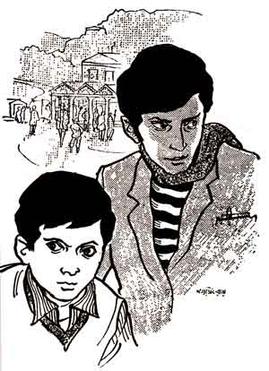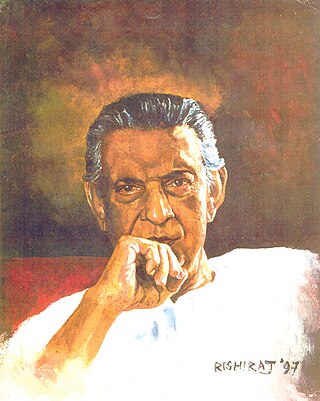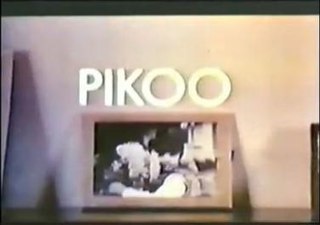
Feluda, or Prodosh Chandra Mitra [Mitter], is a fictional detective, Private investigator created by famous Indian director and writer Satyajit Ray. Feluda resides at 21 Rajani Sen Road, Ballygunge, Calcutta, West Bengal. Feluda first made his appearance in a Bengali children's magazine called Sandesh in 1965, under the editorialship of Ray and Subhas Mukhopadhyay. His first adventure was Feludar Goendagiri. Feluda is one of the most impactful Bengali characters of all time.

Pather Panchali is a 1955 Indian Bengali-language drama film written and directed by Satyajit Ray and produced by the Government of West Bengal. It is an adaptation of Bibhutibhushan Bandyopadhyay's 1929 Bengali novel of the same name, and marked Ray's directorial debut. Featuring Subir Banerjee, Kanu Banerjee, Karuna Banerjee, Uma Dasgupta, Pinaki Sengupta, Chunibala Devi and being the first film in The Apu Trilogy, Pather Panchali depicts the childhood travails of the protagonist Apu and his elder sister Durga amidst the harsh village life of their poor family.

Nayak is a 1966 Indian Bengali-language drama film composed, written, and directed by Satyajit Ray. It was Ray's second entirely original screenplay, after Kanchenjungha (1962). The story revolves around a matinee idol on a 24-hour train journey from Kolkata to Delhi to receive a national award. However, he ends up revealing his mistakes, insecurities and regrets to a young journalist, who realises that behind all his arrogant facade lies a deeply troubled man as his life's story is gradually revealed through seven flashbacks and two dreams. The film starring Uttam Kumar in main protagonist and Sharmila Tagore played second lead.

Ghare Baire is a 1984 Indian Bengali-language romantic drama film directed and written by Satyajit Ray. Based on Rabindranath Tagore's novel of the same name, starring Soumitra Chatterjee, Victor Banerjee, Jennifer Kendal and Swatilekha Chatterjee. The film has a complex portrayal of several themes including nationalism, women emancipation, spiritual and materialistic take on life, tradition versus modernism, and others.

Goopy Gyne Bagha Byne is a 1969 Indian fantasy adventure comedy film written and directed by Satyajit Ray and based on a story by his grandfather Upendrakishore Ray Chowdhury. It is a fantasy-musical film, with the music and lyrics written by Ray himself. This is the first film of the Goopy - Bagha series, and there are two sequels - Hirak Rajar Deshe, which was released in 1980, and Goopy Bagha Phire Elo, written by Satyajit Ray but directed by his son Sandip Ray, which was released in 1992.

Satyajit Ray was an Indian filmmaker who worked prominently in Bengali cinema and who has often been regarded as one of the greatest directors of world cinema. Ray was born in Calcutta to a Bengali family and started his career as a junior visualiser. His meeting with French film director Jean Renoir, who had come to Calcutta in 1949 to shoot his film The River (1951), and his 1950 visit to London, where he saw Vittorio De Sica's Ladri di biciclette (1948), inspired Ray to become a film-maker. Ray made his directorial debut in 1955 with Pather Panchali and directed 36 films, comprising 29 feature films, five documentaries, and two short films.

Satyajit Ray (1921–1992), a Bengali film director from India, is well known for his contributions to Bengali literature. He created two of the most famous characters in Feluda the sleuth, and Professor Shonku the scientist. He wrote several short novels and stories in addition to those based on these two characters. His fiction was targeted mainly at younger readers, though it became popular among children and adults alike.

Rabindranath Tagore is a 1961 Indian documentary film written and directed by Satyajit Ray about the life and works of noted Bengali author Rabindranath Tagore. Ray started working on the documentary in early 1958. Shot in black-and-white, the finished film was released during the birth centenary year of Rabindranath Tagore, who was born on 7 May 1861. Ray avoided the controversial aspects of Tagore's life in order to make it as an official portrait of the poet. Though Tagore was known as a poet, Ray did not use any of Tagore's poetry as he was not happy with the English translation and believed that "it would not make the right impression if recited" and people would not consider Tagore "a very great poet," based on those translations. Satyajit Ray has been reported to have said about the documentary Rabindranath Tagore in his biography Satyajit Ray: The Inner Eye by W. Andrew Robinson that, "Ten or twelve minutes of it are among the most moving and powerful things that I have produced."

The Inner Eye is a 1972 short documentary film made by Satyajit Ray on Benode Behari Mukherjee, a blind artist and a teacher from Visva-Bharati University, a university founded by Rabindranath Tagore at Santiniketan. The twenty minutes documentary features the life and works of Mukherjee in the form of paintings and photographs, starring himself. The documentary covers his journey from childhood till his blindness along with much of his works and features his words, "Blindness is a new feeling, a new experience, a new state of being". The documentary was awarded as Best Information Film (Documentary) at 20th National Film Awards in 1972.

Bala is a 1976 documentary film made by Satyajit Ray, about a Bharatanatyam dancer, Balasaraswati, fondly known as "Bala". The film was jointly produced by National Centre for the Performing Arts and Government of Tamil Nadu. The thirty-three-minute documentary features the life and some of the works by Balasaraswati in the form of narration and dance, starring herself. At the age of fourteen, Ray had seen a performance of Balasaraswati in Kolkata, then known as "Calcutta", in 1935, when she was seventeen years old.

Sandip Ray is an Indian film director and music director who mainly works in Bengali cinema. He is the only child of the famous Indian director Satyajit Ray and Bijoya Ray.
Parallel cinema, or New Indian Cinema, is a film movement in Indian cinema that originated in the state of West Bengal in the 1950s as an alternative to the mainstream commercial Indian cinema.

Pikoo is a 1980 Bengali short film directed by Satyajit Ray for a French television channel, France 3. The film is based on a short story named Pikoor Diary, written by Ray for one of his books, Pikoor Diary O Onyanyo. The film showcases a day in the life of a six-year-old child, Pikoo, in the backdrop of his mother's extramarital affair.
The Alien was an unproduced Indian-American science fiction film in development in the late 1960s which was eventually cancelled. It was to be directed by Indian filmmaker Satyajit Ray and co-produced by Columbia Pictures. The script was written by Ray in 1967, loosely based on Bankubabur Bandhu, a Bengali science fiction story he had written in 1962 for Sandesh, the Ray family magazine, which gained popularity among Bengalis in the early 1960s. Bankubabur Bandhu was eventually adapted into a television film by Satyajit Ray's son Sandip Ray, and a play by the theatre group Swapnasandhani Kaushik Sen, in 2006.

Satyajit Ray was an Indian director, screenwriter, documentary filmmaker, author, essayist, lyricist, magazine editor, illustrator, calligrapher, and composer. Widely considered one of the greatest film-makers of all time, Ray is celebrated for works including The Apu Trilogy (1955–1959), The Music Room (1958), The Big City (1963) and Charulata (1964) and the Goopy–Bagha trilogy.

Cinema of West Bengal, also known as Bengali cinema or Tollywood, is an Indian film industry of Bengali-language motion pictures. It is based in the Tollygunge region of Kolkata, West Bengal, India. The origins of the nickname Tollywood, a portmanteau of the words Tollygunge and Hollywood, dates back to 1932. It was a historically important film industry, at one time the centre of Indian film production. The Bengali film industry is known for producing many of Indian cinema's most critically acclaimed global Parallel Cinema and art films, with several of its filmmakers gaining prominence at the Indian National Film Awards as well as international acclaim.
Feluda is an Indian-Bengali detective media franchise created by Indian-Bengali film director and writer Satyajit Ray, featuring the character, Feluda. The titular character is a private investigator starring in a series of Bengali novels and short stories. The detective resides at 21 Rajani Sen Road, Ballygunge, Kolkata, West Bengal, India. Feluda first made his appearance in a Bengali children's magazine called Sandesh (সন্দেশ) in 1965, under the editorialship of Satyajit and Subhas Mukhopadhyay. His first adventure was Feludar Goendagiri.

Jekhane Bhooter Bhoy is a 2012 Indian Bengali film directed by Sandip Ray. There are three short ghost stories in this film.

Phatik Chand is a Bengali children's film directed by Sandip Ray based on the novel of Satyajit Ray in the same name. This was the directorial debut of Sandip Ray, and was released in 1983. This film received Best feature film award at the International Children's Film Festival in Vancouver in 1984.

















